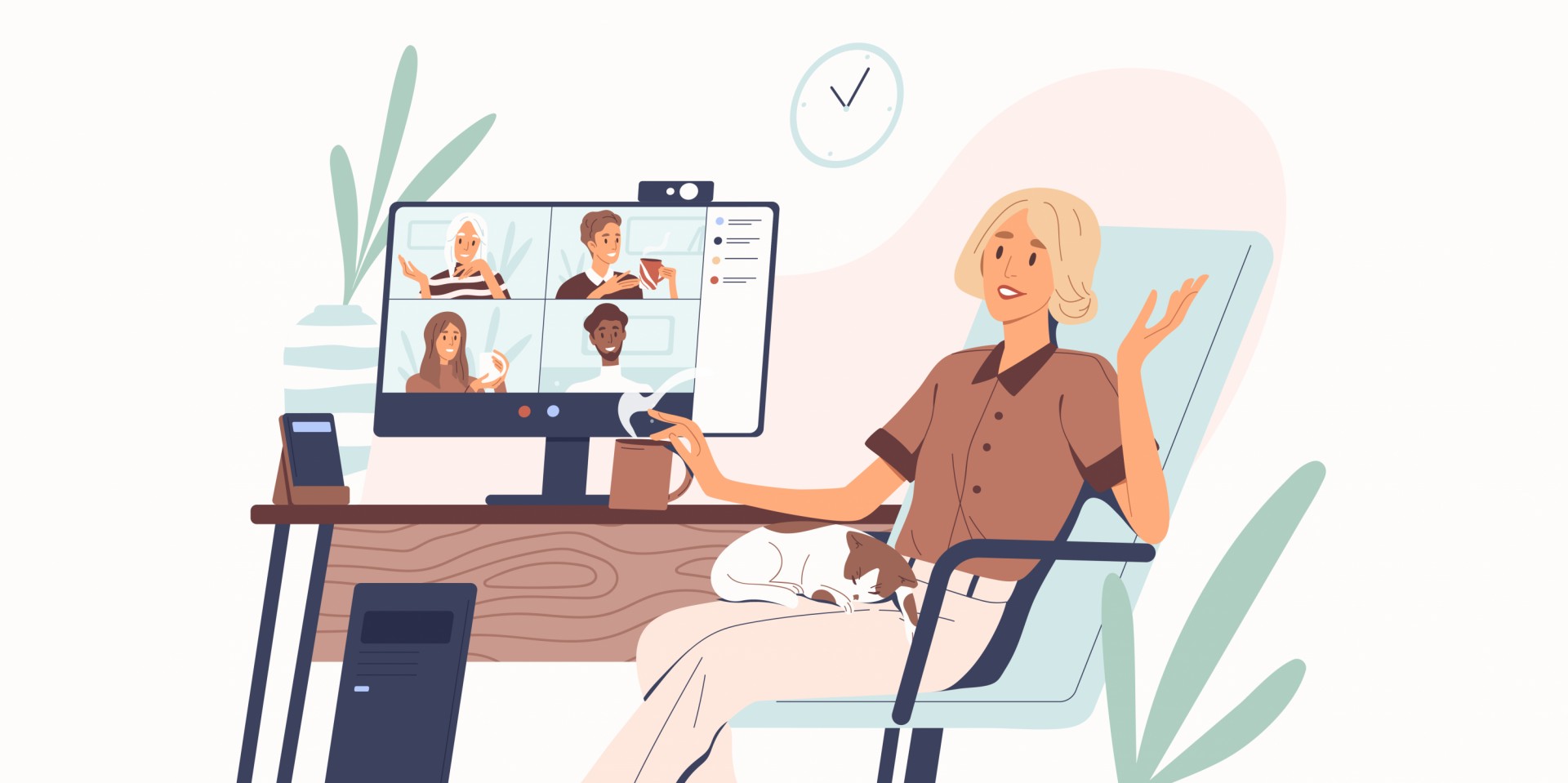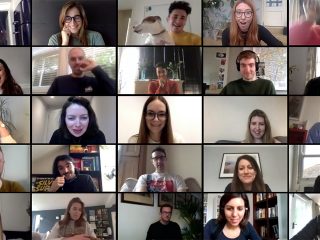From pitching over Zoom to dreaming up creative from the kitchen table, the pandemic has forced the ad industry to adapt and service clients remotely. With many now acclimatised to a more digital way of working, will we see a new generation of virtual ad agencies open shop? And what would a lack of physical working spaces mean for creativity and agency culture?
Office space has long been a focal point for ad agencies. The well-lit ‘meet our team’ group shot, taken against an exposed brick wall, pool table visible in the background, is standard fare on the websites of most creative shops.
When it comes to pitching and chemistry meetings, those four walls can serve as a differentiator. For creatives, copywriters and planners, the office is a hub where campaigns come to life. For agency management, it can be a concrete monument to their business culture.
Amid coronavirus, though, the forced closure of physical spaces has seen ad execs pivot to remote ways of working, collaborating with far-flung colleagues to get creative over the line for clients.
Almost three months into this new normal, agencies are settling into the groove and realising that the world has not stopped. They might have had to rethink how they work, but agency teams are still producing work for some of the world’s biggest advertisers; pitches are still going ahead, just over Zoom; and M&A activity is getting green-lit.
With many staffers at holding companies and indies alike still unsure about when they’ll return to their desks, the opportunity is ripe for the emergence of a new wave of virtual agencies, which take the lessons learned in lockdown and champion an entirely new way of working.
But is the industry ready to embrace a truly virtual model? And what would a lack of physical spaces mean for both agency culture and creativity?
The rise of the virtual agency
Full-service virtual ad agencies and digital creative collectives have been springing up across the industry for the past decade. Pre-pandemic, players like Ogmog (a US virtual design consultancy) and Frontroom (which counts Clinique and Nintendo among its clients) emerged to challenge bricks and mortar rivals.
Outfits which connect brands with freelance individuals and teams had also been steadily growing in popularity pre-Covid-19, including US-based Working Not Working, Australia’s The Freelance Collective and The Dots in the UK.
With holding companies squeezed for cash and many creatives from smaller agencies displaced, does this pave the way for yet more virtual models to rise from the ashes of the pandemic?
Paul Houlding, chief executive at indie shop Isobel, is on the fence. “The truth is that virtual agencies have always existed but never really got any traction. You have to ask why and whether now will be any different.”
He believes that with many people furloughed or made redundant, the draw of being able to start a business with “absolutely zero physical cost” beyond a website will pave the way for a host of virtual agency startups, which champion “an entirely new way of working.”
“Virtual agency models existed pre-coronavirus,” agrees Zaid Al-Zaidy, group chief executive of The Beyond Collective. But while he acknowledges there’s room for them in the industry, he remains an advocate for physical outfits.
“I think it’s much more likely that all agencies will adopt a real-meets-virtual hybrid model, which offers greater flexibility, and makes the most of the technology which has demonstrated itself to be fit for WFH success.”
For Helen James, managing director of Crispin Porter Bogusky London, unlike the faddish rush to open virtual agencies in Second Life back in the noughties, this time the ad industry’s push to virtual is the result of real necessity.
“Necessity is, of course, the mother of invention, and to use some innovation language, new product development has quickly progressed, and those of us effectively working in a virtual agency now are probably pleasantly surprised by how smooth the shift has been. Smooth, but also remarkably effective,” she says.
She is keen to stress though, that post-pandemic her own agency has no plans to go virtual any time soon.
“For me that’s a binary response to the traditional office setup, and one that ignores the energy that fizzes when a team comes together and how powerful that can be in an industry like ours.”
Keeping the creative spark alive
Though agencies have developed quick-fire, reactive work for everyone from Microsoft to Mars under lockdown, recent research from Mother London found that customers are getting fatigued with remotely produced Zoom-style ads.
In lieu of creatives, copywriters, planners and other members of staff being able to sit side-by-side, industry voices are concerned that the quality of work could suffer if agencies retire their offices entirely.
“So much of the creative magic in agencies comes from the agency culture and frankly, there’s no way to replace the spark which happens when creative minds are in a room together,” says Al-Zaidy. “Having said that, pitching on Zoom limits the amount of bells and whistles theatre that can be done – which is no bad thing – and ensures that the focus is rightly on the work.”
CPB’s James says this has been a challenge her team has already observed in working from home. “The creative teams, by their very nature, tend to feed off each other, bounce ideas off each other, censor each other, usually huddled together in a corner on comfy sofas.
“That necessary element of togetherness can’t ever be made fully virtual, in a virtual world there are no ‘creative collisions’ that lead to serendipitous avenues and ideas.”
So what would the ideal virtual agency look like for her should it come to the crunch? “It would be a semi-virtual agency. We take all the learnings from the last three months during lockdown and apply them to a new way of working: an office hub where people hotdesk, and x days a week or month everyone is present.
“The rest of the time people work flexibly and often remotely, using the power of tech to stay connected to each other and clients.“
She notes that the opportunity with remote employees would mean her agency could hire based purely on ability and experience, perhaps allowing for some ability and willingness to travel to weekly or monthly face-to-face meetings.
“Lower in-office overheads could be used to subsidise or fully cover these travel costs, enabling a hub-and-spoke way of working.”
Frazier Gibney, who is chief executive at FCB inferno, reveals that his agency is in the midst of embracing a hybrid approach amid the pandemic. Like most though, it has leases and financial commitments. While he’s aware of technologies like telepresence robot screens and tandem virtual offices which could allow employees to work together, apart, he’s not sold on the idea.
“To me the technology that can show where everyone is feels a step too far and a bit too Big Brother-esque,” he says.
If anything, he argues that lockdown has shown the value of having a space for staff to congregate.
“Nobody got into the advertising industry to work in isolation, or on Zoom calls. We thrive on interaction and collaboration and that’s where culture comes from. I can’t imagine our agency without a home. I think we will be looking to reconfigure our space to make it feel more like the creative home it should be.”
Creating culture, virtually
Wayne Deakin, creative director at Huge, contends that agency culture isn’t the buildings themselves or “some cool shit on the walls.”
“Culture is about a set of shared values and a clear vision. You don’t need a curated environment to have great culture,” he notes. “It’s the most important thing in my view and goes beyond the superficial environment of an office. It’s something that is a bottom-up thing that you feel as a set of beliefs and demonstrate through the work and approach.
“My experience has been that our own agency culture at Huge has only got stronger in this isolation but it’s important to keep it flourishing by actions and making sure everyone in the agency gets a chance to participate and contribute.”
Where Gibney sees the office as a hotbed for agency culture to thrive and Deakin believes remote practices have made his agency stronger, others observe that the virtual lessons learned from the pandemic could give ad land a chance to retune its cultural norms.
Iris creative director Gabi Mostert asserts that if the last three months have taught us anything, it’s that business as usual is “broken” in agency land.
She agrees that virtual agencies will find it difficult to refine their culture, but notes there is potential for the industry to change for the better.
“So much of agency culture is centred on the physical working space, the neighbourhood and the local boozer,” she explains. “Having said that, a virtual agency creates the opportunity for a new, more expansive culture. One that isn’t solely defined by mad nights out, Christmas parties, toxic cliques and agency bro culture.”
She’s already conceived what her own virtual agency might look like; after many Zoom calls, it’s aptly named You’re On Mute.
“We’re extremely brilliant and progressive. We never have more than two people who look or sound the same working on a brief. We have ‘moving meetings’ where we walk and talk in our local park. We interrogate a brand’s core values and their racial/gender pay-gap before ever agreeing to pitch.
“We have four-day weeks. No decks are allowed to be more than 12 pages. We aren’t masochistic perfectionists like we used to be in our old lives. Our white teammates recognise the privilege this industry has afforded them, and actively give platform and space to black and minority talent. We love our work, hustle hard, and do good for good businesses.
“We don’t make much money unfortunately, but we sleep well at night and we know it’ll be worth it in the long run.”
Sounds virtually perfect, right?
This article was originally posted in The Drum.




